Beelink GTR6 Internal Hardware Overview
Opening the bottom cover, we have something new. There is a small fan designed to cool the memory and SSDs. The horizontal grooves in the photo below are actually an integrated heatsink for the SSDs.
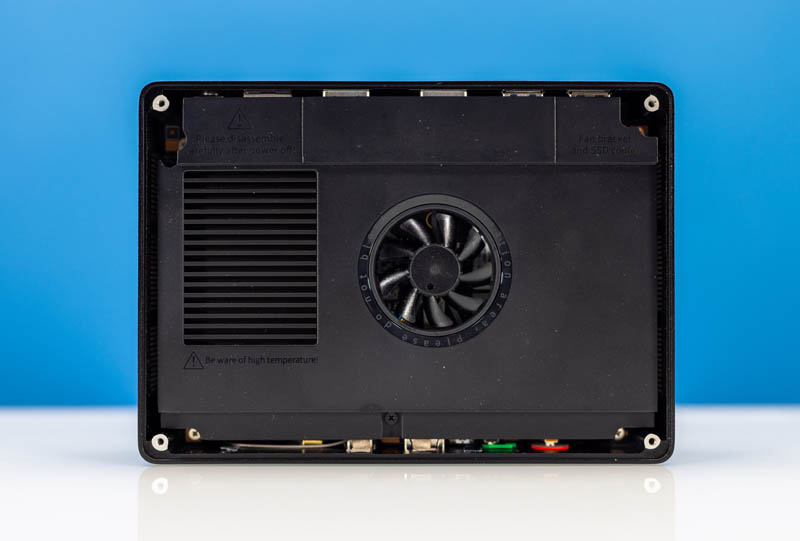
Three screws later, and we can take this cover off. Here we can see the user-serviceable area. There are two M.2 slots to the left, one NVMe, and one SATA. On the right, there are two DDR5-4800 SODIMM slots.
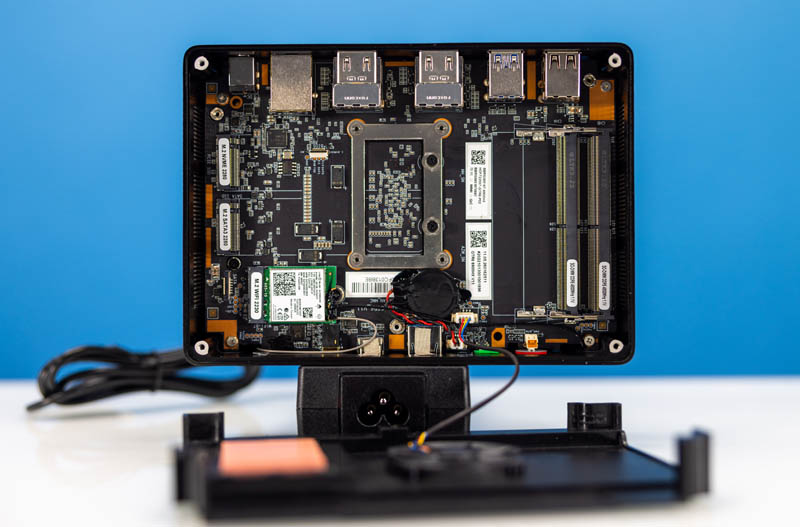
The unit came with an Intel AX210 WiFi 6E card built-in as well.
Here is the unit configured with the Kingston KC3000 and Crucial DDR5 16GB SODIMMs.
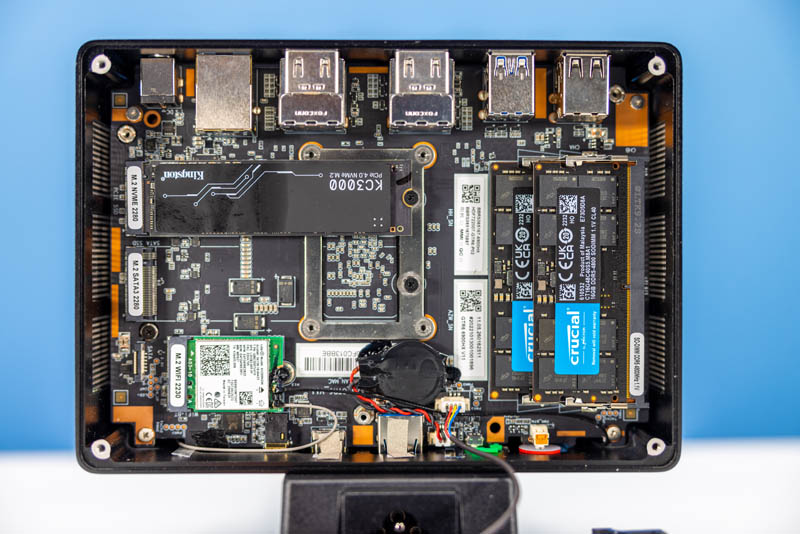
We like that these are name brands that we recognize for bundled components. Some of the mini PCs we have reviewed have unknown brands for SODIMMs and M.2 SSDs to save a few dollars on production.
Next, let us get to the performance.
Beelink GTR6 AMD Ryzen 6900HX Performance
Instead of going through the entire Linux-Bench test suite, we are going to show a few performance and power numbers here to give a general sense of performance. This also gives us the opportunity to test with Linux/ Ubuntu instead of just Windows.
Python Linux 4.4.2 Kernel Compile Benchmark
This is one of the most requested benchmarks for STH over the past few years. The task was simple, we have a standard configuration file, the Linux 4.4.2 kernel from kernel.org, and make the standard auto-generated configuration utilizing every thread in the system. We are expressing results in terms of compiles per hour to make the results easier to read:
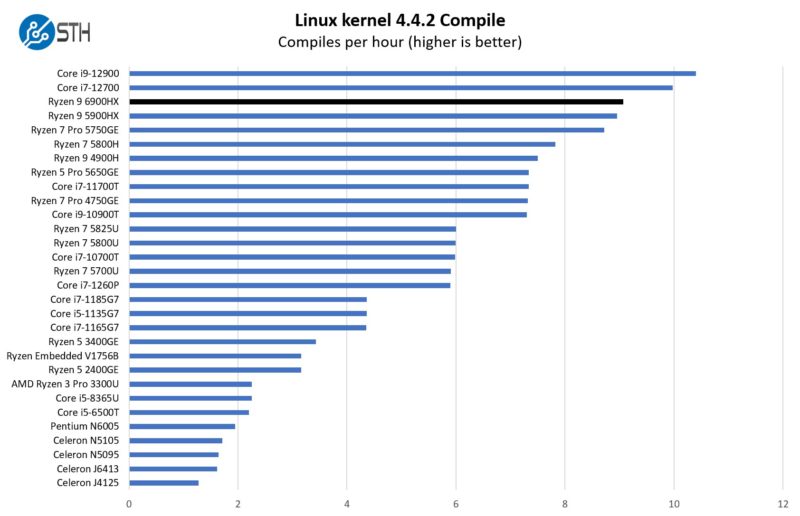
This is going to be a trend. While the 8-core / 16-thread processor is certainly capable, it is only a 45W TDP part. Compared with the 65W TDP 12th Gen Intel Core processors, performance is sacrificed for lower power consumption. In our power consumption section, we will discuss how this actually used less power than the Intel Core i7-1260P 12th Gen Intel NUC that we just reviewed.
7-zip Compression Performance
7-zip is a widely used compression/ decompression program that works cross-platform. We started using the program during our early days with Windows testing. It is now part of Linux-Bench.
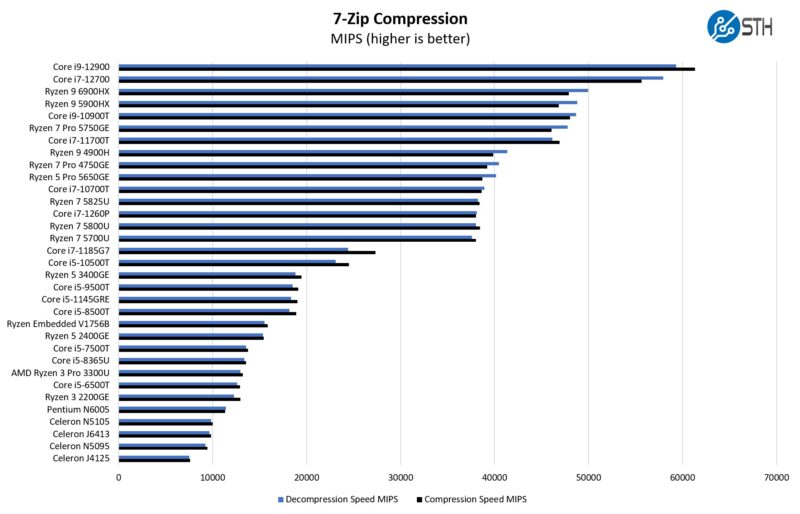
Compared to the AMD Ryzen 9 5900HX that we saw in the previous GTR5 version, the AMD Ryzen 9 6900HX is faster but not by a huge margin.
OpenSSL Performance
OpenSSL is widely used to secure communications between servers. This is an important protocol in many server stacks. We first look at our sign tests:
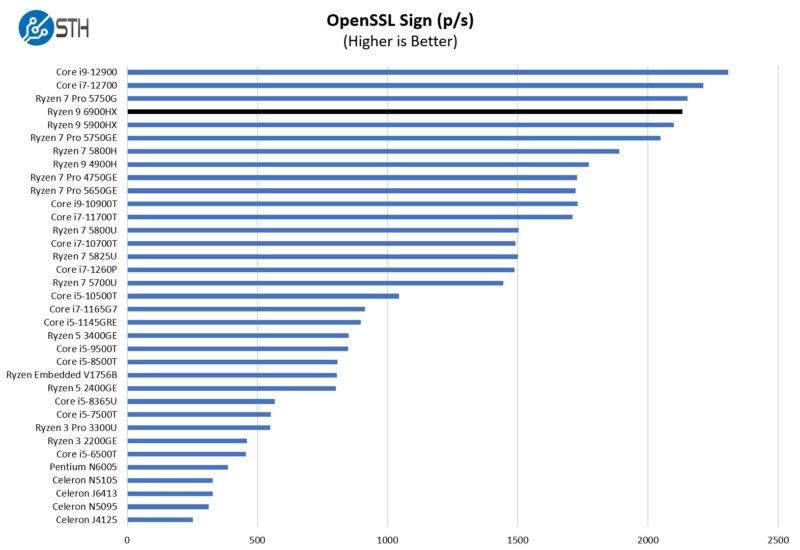
Here are the verify results:
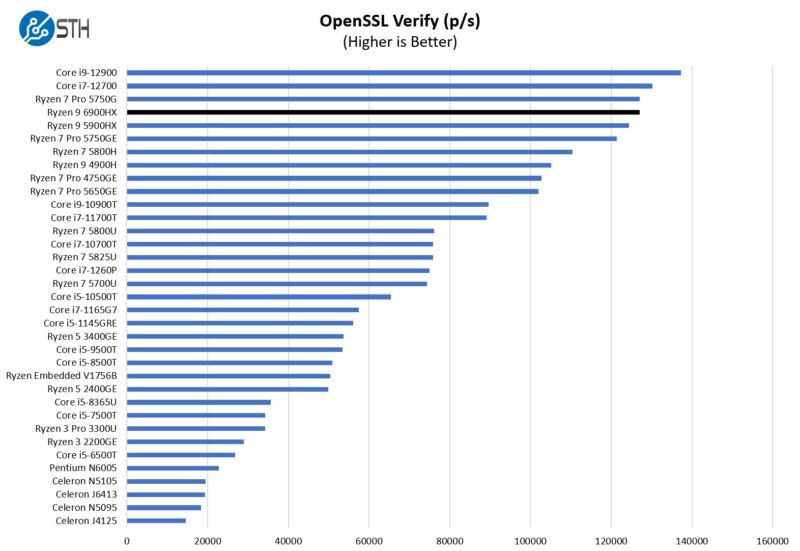
These are very capable processors, but we do not think that the CPU performance warrants an upgrade from the AMD Ryzen 9 5900HX to the AMD Ryzen 9 6900HX. The difference across the board was just not enough.
GeekBench 5 and League of Legends Results from the Video
Since we used GeekBench 5 to demonstrate the power consumption of the system so we have a result from when we were running the unit live in the video. You can find that result here.
Since we get asked several times for each review about the gaming performance, we showed it in this instance with League of Legends at 1080p and 4K while also recording the screen via OBS. Generally, 4K had a lot of dips into the 40fps range, but the 1080p was often in the 70-100fps range. 1080p felt very playable against bots.
Next, let us get to our power consumption and noise section.



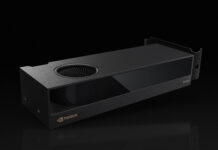
No mention of ECC support or lack thereof?
When it comes to the benchmarks and you have 2 columns for one entry (like with the 7zip compression) could you make the subject CPU a different color so that it stands out more like how you change the subject CPU to black in all the other benchmark scores?
That fan looks shockingly small.
Not sure what these manufacturers are thinking. I had a NUC and a Gigabyte Brix about 8 years ago. Every year I look at newer NUC-type devices but noise only got better.
Noise levels should be a priority and slightly bigger systems with bigger coolers won’t hurt nobody.
Lasertoe:
Yes exactly. No one cares about 1-2 cm thickness, but everyone hears the noise. I don’t understand manufacturers.
Is there any advantage to sticking with a barrel plug on these aside from their BOM cost? Surely a 100W USB-C PD cable would have been a more sensible solution. They could have used the same power brick with a fixed cable but with a USB-C plug instead of a barrel plug (like Lenovo does) and limited tuned it down to 100W at 20V instead of 120W at 19V, or kept to the newest USB-C PD standard using 140W at 28V and give more head room.
I have one of the previous model, GTR5, bought largely on the basis of its review here at STH.
It is an impressive little box. For 10 to 50 watts it shows up full power desktop processors of just a generation back. Adding a 2TB 2.5″ SSD was easy.
The Beelink name makes sense as the fan sounds like an annoyed bee if pushed. This is rarely an issue for me as I use it in my living room to run a TV. Most uses do not trigger the fan. If I push it and the fan bugs me I can set the powersave governor and it shuts up at lower but still good performance. Would I want a bigger box for less fan noise? Yes.
Everything works in Windows, except, well, Windows. I use it in Linux where it serves despite some issues.
With a nice old 4k monitor 60Hz only works with displayport and no sound. This is true of the USB-C displayport mode and the native displayport plug. HDMI only gets 30Hz on native cables, same with conversion to displayport. I spent long hours down the EDID rathole with no resolution. I think the answer is Windows has tables of quirks for monitors and the AMD Linux drivers do not. Perhaps if I got the right EDID I could have made it work.
The WiFi has great throughput but 50ms latency. Works right in Windows. Wired ethernet works all around.
HDMI to a TV, only a few months newer than the 4k monitor, works all around, 4k, 60Hz, sound, everything. Just have to make sure the TV is already turned on when the Beelink boots up or, well, reboot it.
I would anticipate similar results with the GTR6, great performance for tiny power in a tiny box but annoying video issues in Linux. HDMI only is a step back.
Price of these things feels a lot like a robbery. It’s essentially SoC on aboard with a few connectors FFS – no special chipset etc etc. And yet they are pricing it as if it were complete notebook.
One might be better off by waiting for new APUs to come out and then going for mini-ITX board and perhaps adding some periphery (10G Eth etc etc).
True that no AM5 MoBop has 4 GFX outputs, but that’s what the DP MST HUB is about…
I think Ansi is right, but it’s also a problem of them changing prices all the time. At $750 you’d have $225 for the SSD and RAM and then it’s $525 for the rest. CPU, motherboard, case, power supply and Windows 11 Pro for that isn’t too bad. Let’s also take that you don’t have to order and assemble and install Windows so it’ll save time too.
At $850 it’s too much of a premium and I’d agree with Ansi
If you are willing to accept STX systems (size bigger than NUC but smaller than mini-ITX) but want a cheap, small and low noise system Asrocks Deskmini is probably the way to go.
I have one X300 here and with a Noctua NH-L9a noise is pretty good. A newer B660 is available too. AMD X600 & Intel B760 should arrive soon.
It doesn’t look as cool as those small NUC-type systems though.
Just another comment agreeing on the fan situation.
Why can’t they just design these things to make use of a STANDARD format fan (e.g. 120x120x25mm). Sure it’d make the thing slightly larger, but one such fan can be effective for quite a bit of power with very little noise (if the air path is designed properly). And it’s replaceable!!! Users can pick & choose their own fans, for different priorities, like noise or reliablility.
Oh, and as mentioned by another commenter, no ECC support??
No wonder I just stick to my own mini-ITX builds. My current low-power home server has just one 120mm fan, has ECC memory, and is powered by DC supply (M3-ATX).
Great review. I will get a GTR6 Ryzen 9 (or maybe the Ryzen 7) based on this review. Previously your GTR5 review pointed me to the Beelink Mini’s. I purchased multiple SER5 Ryzen 5 5600U’s. Really solid Win11 Pro PC’s. Came with Kingston & Crucial 16GB memory. New SER5’s have 32GB. Mine have NVMe 512GB or 1TB drives. The basement has room for an SSD. Only 1GB NIC but all are connected with 2.5GB adapters connected to a USB and QNAP & Synology network servers. Drives multiple monitors at each desk. Looking forward to the GTR6. Latest I’ve seen on Amaz.: GTR6 Ryzen 9 ($970), GTR6 Ryzen 7 ($585), SER5 Ryzen 5 ($369). Thanks again for the Beelink Mini update.
Its extremely noisy even in idle, I wish reviews actually pointed this out more, because it’s a huge deal